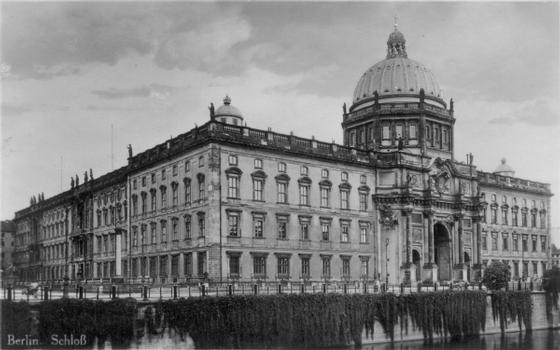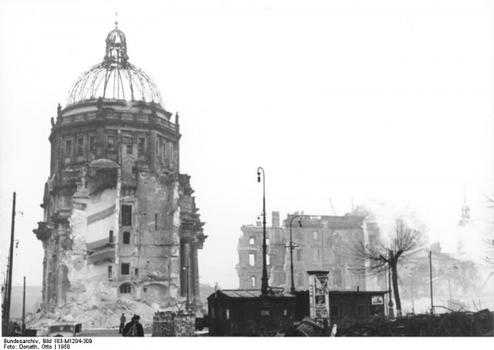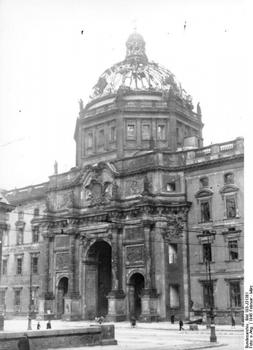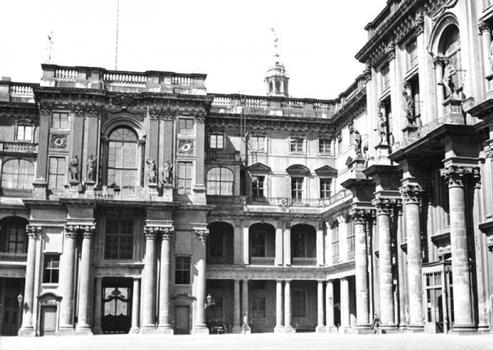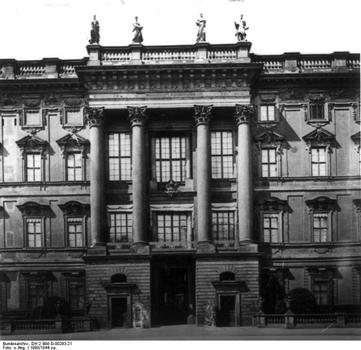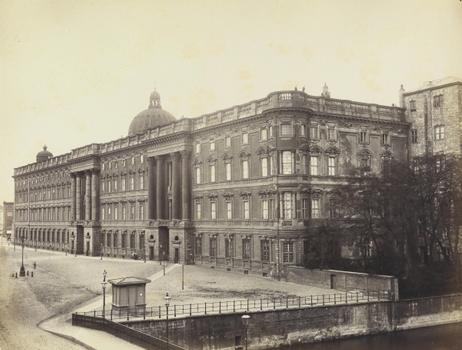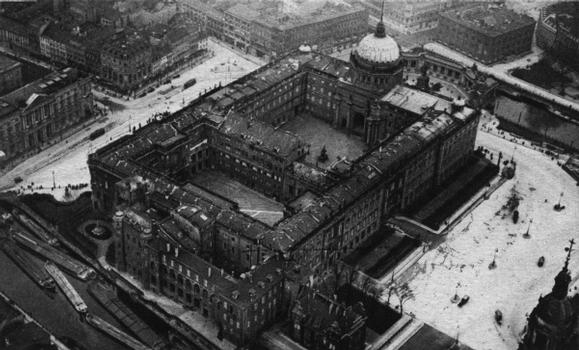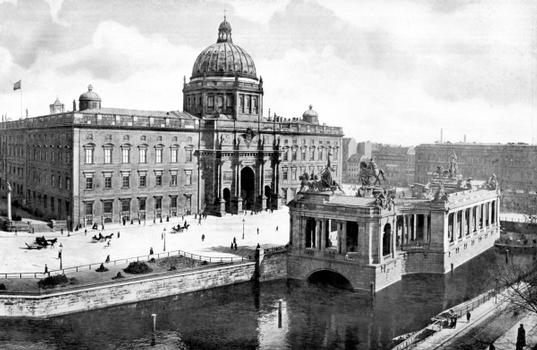General Information
| Name in local language: | Berliner Stadtschloss |
|---|---|
| Beginning of works: | 1443 |
| Completion: | 1894 |
| Status: | demolished (1950) |
Project Type
| Function / usage: |
Château |
|---|---|
| Material: |
Masonry structure |
| Architectural style: |
Gothic |
| Structure: |
Dome |
| Architectural style: |
Renaissance Baroque Neoclassical |
Location
| Location: |
Berlin-Mitte, Mitte, Berlin, Germany |
|---|---|
| See also: |
Humbold Forum (2020)
|
| Coordinates: | 52° 31' 2.13" N 13° 24' 5.37" E |
Technical Information
Dimensions
| height | 35 m | |
| height to tip of dome | 60 m |
Excerpt from Wikipedia
The Berlin Palace (German:Berliner Schloss), formally the Royal Palace (German:Königliches Schloss), on the Museum Island in Berlin was the main residence of the House of Hohenzollern from 1443 to 1918. Expanded by order of King Frederick I of Prussia according to plans by Andreas Schlüter from 1689 to 1713, it was thereafter considered a major work of Prussian Baroque architecture. The former royal palace was one of Berlin’s largest buildings and shaped the cityscape with its 60-meter (200 ft)-high dome. Damaged during the Allied bombing in World War II, it was demolished by the East German authorities in 1950, and later became the location of the modernist East German Palace of the Republic. After German reunification and several decades of debate and discussion, the Palace of the Republic was itself demolished and the Berlin Palace was reconstructed to house the Humboldt Forum museum.
Overview
The Berlin Palace, also incorrectly known as the City Palace (German:Stadtschloss), is a building in the centre of Berlin, located on the Museum Island at Schlossplatz opposite the Lustgarten park. From the 15th century to the early 20th century, the Berliner Schloss was a royal and imperial palace that mostly served as the main residence of the Electors of Brandenburg, the Kings of Prussia, and the German Emperors. Damaged during World War II and later demolished by the East German government in the 1950s, the palace is being partially rebuilt, with completion expected in 2020. The reconstructed palace is the seat of the Humboldt Forum, a museum for world culture which is a successor museum of the Ancient Prussian Art Chamber, which was also located in the 19th century-Berlin Palace. The Humboldt Forum has been described as the German equivalent of the British Museum.
The palace was originally built in the 15th century, but had changed in form throughout the next few centuries. It bore features of the Baroque style; its shape, which had been finalized by the mid-18th century, is for the most part attributed to German architect Andreas Schlüter, whose first design is likely to date from 1702, even though the palace incorporated earlier parts as seen in 1688 by Nicodemus Tessin. It served as a residence to various Electors of Brandenburg. It was the principal residence and winter residence of the Hohenzollern Kings of Prussia from 1701 to 1918. After the unification of Germany in 1871, it also became the central residence for the German Emperors, who also served as the Kings of Prussia. After the proclamation of the Weimar Republic in 1918, the palace became a museum. In World War II, the building was heavily damaged by Allied bombings. Although it is thought to have been repairable, the palace was demolished in 1950 by the German Democratic Republic authorities following much criticism. In the 1970s, the Palace of the Republic was constructed on its site, but was controversially demolished in 2008 to make place for a reconstruction of the old palace.
Following the reunification of Germany, it was decided to rebuild the entire exterior of the palace in the original style except for the east side. The authentically reconstructed facades includes various remnant sculptures and stones of the original palace. The interior is modern, except the facades of one of the courts which are constructed in original style (Schlüterhof). The floorplan has been designed to allow future reconstruction of notable historical rooms. The building houses the Humboldtforum museum and congress complex, and was finished in 2020.
History up to 1871
The palace replaced an earlier fort or castle guarding the crossing of the Spree river at Cölln, a neighbouring town which merged with Berlin in 1710. The castle stood on Fishers' Island, as the southern end of the Museum Island in the Spree is known. In 1443 Frederick II "Irontooth", Margrave and Prince Elector of Brandenburg, laid the foundations of Berlin's first fortification in a section of swampy wasteland north of Cölln. At the completion of the castle in 1451, Frederick moved there from the town of Brandenburg. The main role of the castle and its garrison in this period was to establish the authority of the Margraves over the unruly citizens of Berlin, who were reluctant to give up their medieval privileges to a monarchy. In 1415 King Sigismund had enfeoffed the Hohenzollern princes with Brandenburg, and they were now establishing their power and withdrawing electoral privileges which the cities had attained in the Brandenburg interregnum of 1319–1415.
The castle also included a chapel. In 1454 Frederick II, after having returned via Rome from his pilgrimage to Jerusalem, made the castle chapel a parish church, richly endowing it with relics and altars. Pope Nicholas V ordered Stephan Bodecker, then Prince-Bishop of Brandenburg, to consecrate the Chapel to Erasmus of Formiae.
On 7 April 1465, at Frederick's request, Pope Paul II attributed to St Erasmus Chapel a canon-law College named Stift zu Ehren Unserer Lieben Frauen, des heiligen Kreuzes, St. Petri und Pauli, St. Erasmi und St. Nicolai. This collegiate church became the nucleus of today's Evangelical Supreme Parish and Collegiate Church, adjoining the site of the castle.
In 1538, the Margrave Joachim II demolished the palace and engaged the master builder Caspar Theiss to build a new and grander building in the Italian Renaissance style. After the Thirty Years War (1618–1648), Frederick William (1620–1688), the "Great Elector", embellished the palace further. In 1688, Nicodemus Tessin designed courtyard arcades with massive columns in front. Not much is known about the alterations of 1690–1695, when Johann Nering was the court architect. Martin Grünberg continued the alterations in 1695–1699.
In 1699, the Elector Frederick III of Brandenburg (who took the title King in Prussia in 1701, becoming Frederick I), appointed the architect Andreas Schlüter to execute a "second plan" in the Italian manner. Schlüter's first design probably dates from 1702; he planned to rebuild the palace in the Protestant Baroque style. His overall concept in the shape of a regular cube enclosing a magnificently ornamented courtyard was retained by all the building directors who succeeded him. In 1706, Schlüter was replaced by Johann Friedrich Eosander von Göthe, who designed the western extension of the palace, doubling its size. In all essentials, Schlüter's balanced, rhythmic composition of the façades was retained, but Göthe moved the main entrance to the new west wing.
Berliner Schloss was the original location for the Amber Room, but Peter the Great of Russia admired it during a visit and in 1716 Frederick William I presented the room to Peter as a gift.
Frederick William I, who became king in 1713, was interested mainly in building up Prussia as a military power, and dismissed most of the craftsmen working on the Stadtschloss. As a result, Göthe's plan was only partly carried out. Nevertheless, the exterior of the palace had come close to its final form by the mid-18th century. The final stage was the erection of the dome in 1845, during the reign of Frederick William IV. The dome was built by Friedrich August Stüler after a design by Karl Friedrich Schinkel. Subsequent major works were limited to the interior, engaging the talents of Georg Wenzeslaus von Knobelsdorff, Carl von Gontard and many others.
The Stadtschloss was itself the epicenter of the Revolution of 1848 in Prussia. Huge crowds gathered outside the palace to present an "address to the king" containing their demands for a constitution, liberal reform and German unification. Frederick William emerged from the palace to accept their demands. On 18 March, a large demonstration outside the Stadtschloss led to bloodshed and the outbreak of street fighting. Frederick William later reneged on his promises and reimposed an autocratic regime. From that time onwards, many Berliners and other Germans came to see the Stadtschloss as a symbol of oppression and "Prussian militarism".
Later history (1871-1989)
In 1871, King William I was elevated to the status of Emperor (Kaiser) of a united Germany, and the Stadtschloss became the symbolic heart of the German Empire. The Empire was (in theory) a constitutional state, and from 1894 onwards, the new Reichstag building, the seat of the German parliament came to not only rival but overshadow the Stadtschloss as the Empire's center of power. In conjunction with Germany's defeat in World War I, William II was forced to abdicate both as German Emperor and as King of Prussia. In November 1918, the Spartacist leader, Karl Liebknecht, declared the German Socialist Republic from a balcony of the Stadtschloss, ending more than 400 years of royal occupation of the building.
During the Weimar Republic, parts of the Stadtschloss were turned into a museum, while other parts continued to be used for receptions and other state functions. Under Adolf Hitler's National Socialist (Nazi) Party, which laid to rest monarchist hopes of a Hohenzollern restoration, the building was mostly ignored. During World War II, the Stadtschloss was twice struck by Allied bombs: on 3 February and 24 February 1945. On the latter occasion, when both the air defences and fire-fighting systems of Berlin had been destroyed, the building was struck by incendiaries, lost its roof, and was largely burnt out.
The end of the war saw the Stadtschloss a burned-out shell of its former glory, although the building had remained structurally sound and much of its interior decoration was still preserved. It could have been restored, as many other bombed-out buildings in central Berlin later were. The area in which it was located was within the Soviet Union zone, which became the German Democratic Republic. The building was used for a Soviet war movie ("the Battle of Berlin") in which the Stadtschloss served as a backdrop, with live artillery shells fired at it for the realistic cinematic impact.
The new socialist government declared the Stadtschloss a symbol of Prussian militarism, although at that time there appeared to be no plans to destroy the building. Some parts of it were in fact repaired and used from 1945 to 1950 as an exhibition space. A secret 1950 GDR Ministry of Construction report, only rediscovered in 2016, calculated that reconstruction of the damaged Palace could be achieved for 32 million GDR marks. But in July 1950 Walter Ulbricht, the new General Secretary of the Central Committee of the Socialist Unity Party of Germany, announced the demolition of the palace. Despite objections, its removal commenced in September 1950, the process taking four months and consuming 19 tons of dynamite. So solid was its construction that the dome and its entire mount remained intact even after the rest of the building fell to the ground. Only one section was preserved, a portal from the balcony from which Karl Liebknecht had declared the German Socialist Republic. It was later added to the Council of State building (Staatsratsgebäude), with an altered cartouche, where it forms the main entrance. The empty space where the Stadtschloss had stood was named Marx-Engels-Platz and used as a parade ground.
In 1964, the GDR built a new Staatsrat or Council of State building on part of the site, incorporating Liebknecht's balcony in its facade. From 1973 to 1976, during the government of Erich Honecker, a large modernist building was built, the Palast der Republik (Palace of the Republic), which occupied most of the site of the former Stadtschloss. Shortly before German reunification in October 1990, the Palast der Republik was found to be contaminated with asbestos and was closed to the public. After reunification, the Berlin city government ordered the removal of the asbestos, a process which was completed by 2003. In November 2003, the German federal government decided to demolish the building and leave the area as parkland pending a decision as to its ultimate future. Demolition started in February 2006 and was completed in 2009.
The demolition was lengthy because of the presence of additional asbestos, and because the Palace acted as a counterbalance to the Berliner Dom, across the street, on the unstable grounds of the Museum Island. East Germans resented the demolition, especially those for whom the Palace of the Republic had been a place of fond memories, or who felt a sense of dislocation in a post-communist world. Part of the Palace formed a Stasi surveillance centre that recorded the visitors and staff.
From 2008 until the commencement of construction in 2013, the large area of the original Schlossplatz became a grassed field, laid out on minimal lines with wooden platforms. At the same time, the Berlin Monument Authority (Landesdenkmalamt) undertook extensive archaeological excavations. Parts of cellars that had been situated in the south-west corner of the former Palace were discovered and it was decided these would be preserved and made accessible to visitors as an "archaeological window".
Text imported from Wikipedia article "Berlin Palace" and modified on February 11, 2021 according to the CC-BY-SA 4.0 International license.
Participants
- Andreas Schlüter (architect)
- Johann Friedrich Nilsson Eosander [von Goethe] (architect)
- Friedrich August Stüler (architect)
- Albert Dietrich Schadow (construction supervisor)
Relevant Web Sites
- About this
data sheet - Structure-ID
20066406 - Published on:
06/09/2014 - Last updated on:
28/05/2021

